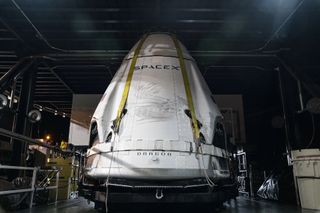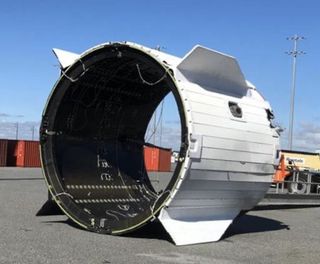SpaceX's Crew Dragon returns to shore after successful abort test (photos)

CAPE CANAVERAL, Fla. — SpaceX's Crew Dragon capsule returned to port Sunday night (Jan. 19), hours after it flawlessly executed a test of its built-in, launch-escape system. The capsule was loaded onto a recovery ship after splashing down in the Atlantic Ocean, and arrived in port later that evening.
The capsule launched atop a veteran Falcon 9 rocket Sunday morning, lifting off at 10:30 a.m. EST (1530 GMT) from NASA's Kennedy Space Center in Florida. Approximately 9 minutes later, the capsule landed in the ocean under parachute, where one of SpaceX's recovery vessels — GO Searcher — was waiting.
Crews aboard the vessel hauled the gumdrop-shaped capsule out of the water and secured it onto the deck. GO Searcher then headed back to port, arriving just before 7 p.m. EST (0000 GMT Monday). Excited onlookers lined the banks of Jetty Park, hoping to catch a glimpse of the craft as it made its way to the U.S. Navy's Trident Turning Basin, where it would be offloaded.
Related: SpaceX's amazing Crew Dragon in-flight abort test launch in photos
Jim Bridenstine, NASA's administrator, tweeted that the capsule had safely made it back to port following some recovery-op testing post splashdown. "She's back," he said on Twitter. "The Crew Dragon spacecraft that completed the in-flight abort test has arrived back at Cape Canaveral."
Soon after, a second recovery ship sailed into port with the Dragon's trunk on board. The trunk acts as a storage compartment; it contains the capsule’s solar arrays and other equipment needed on its trip to the space station. The trunk is typically discarded during re-entry, exposing Dragon’s heat shield and preparing it for landing. Surprisingly, the trunk landed intact after being jettisoned just before the craft's parachutes were deployed.

GO Searcher will also be used to tote the Dragon back to port once SpaceX begins launching astronauts. The ship is equipped with a medical facility and helipad in case of crew emergencies.
Get the Space.com Newsletter
Breaking space news, the latest updates on rocket launches, skywatching events and more!
"After splashdown, teams from SpaceX and the U.S. Air Force 45th Operations Group Detachment-3 rehearsed crew recovery ops before bringing the spacecraft back to port," Bridenstine added.
She’s back! The #CrewDragon spacecraft that completed the in-flight abort test has arrived back at Cape Canaveral. After splashdown, teams from @SpaceX & the @usairforce 45th Operations Group’s Detachment-3 rehearsed crew recovery ops before bringing the spacecraft back to port. pic.twitter.com/Po9TVibS9JJanuary 20, 2020
In a nominal crew landing, the Crew Dragon would be scooped out of the ocean and the crew would be helped to the onboard medical facility for check out while making their way back to port.
Bob Behnken and Doug Hurley are the two NASA astronauts who will fly on SpaceX's first crewed mission. Following the success of Sunday's in-flight abort test, their flight could occur in the next few months. Both SpaceX and NASA are evaluating data now to determine when that launch might be.
- SpaceX's Crew Dragon Demo-1 test flight in pictures
- Watch how SpaceX's Crew Dragon will launch astronauts into space (video)
- SpaceX fires up rocket in prep for 1st astronaut launch with Crew Dragon
Follow Amy Thompson on Twitter @astrogingersnap. Follow us on Twitter @Spacedotcom or Facebook.

Join our Space Forums to keep talking space on the latest missions, night sky and more! And if you have a news tip, correction or comment, let us know at: community@space.com.

Amy Thompson is a Florida-based space and science journalist, who joined Space.com as a contributing writer in 2015. She's passionate about all things space and is a huge science and science-fiction geek. Star Wars is her favorite fandom, with that sassy little droid, R2D2 being her favorite. She studied science at the University of Florida, earning a degree in microbiology. Her work has also been published in Newsweek, VICE, Smithsonian, and many more. Now she chases rockets, writing about launches, commercial space, space station science, and everything in between.
